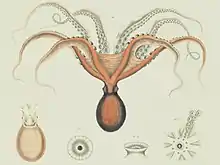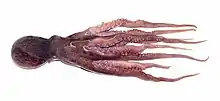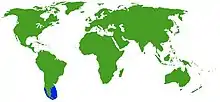Patagonian red octopus
Enteroctopus megalocyathus, also known as Patagonian red octopus (EN), Pulpo del sur (Chile) and Pulpo colorado (Argentina); is a medium-sized octopus, and the type species for the genus Enteroctopus.
| Patagonian red octopus | |
|---|---|
 | |
 | |
| Scientific classification | |
| Domain: | Eukaryota |
| Kingdom: | Animalia |
| Phylum: | Mollusca |
| Class: | Cephalopoda |
| Order: | Octopoda |
| Family: | Enteroctopodidae |
| Genus: | Enteroctopus |
| Species: | E. megalocyathus |
| Binomial name | |
| Enteroctopus megalocyathus (Gould, 1852) | |
| Synonyms | |
Size and description
E. megalocyathus is a relatively large octopus, though not as large as some other giant octopuses like Enteroctopus dofleini. E. megalocyathus has an average mass of around 4 kg.[1] Although, some individuals have outweighed this and reached till 7.5 kg (M) and 8 kg (F).[2] A mantle length of 22.5 cm,[3] and in excess of 1 m in total length,[4] but other author reported a max. total length in Chile of 1.3 m.[5] E. megalocyathus, like other octopuses in the genus Enteroctopus, has longitudinal folds and grooves on the body and large, paddle-like papillae.[6]
Fisheries
E. megalocyathus is one of the two commercially significant octopuses in Chilean waters, along with Octopus mimus. Yearly catch of the two octopuses fluctuates between 2,000 and 5,000 tons.[1]
In Chile, his extraction ban date is from October 15 to March 15, and its range is from the Araucanía region to the Magallanes region,[7] and in regular season, only specimens weighing more than 1 kg are allowed to be extracted.[8]
Predators
Like most octopuses, E. megalocyathus is a choice meal for many predators larger than it. E. megalocyathus has been shown to be a major dietary component of beaked skates (Dipturus chilensis), spiny dogfish (Squalus acanthias),[9] and the South American sea lion (Otaria flavescens).[10]
Range

This octopus is native to the southeastern coast of South America along the coasts of Argentina (Atlantic Ocean) and Chile (Pacific Ocean). In Chile ranges from north Patagonia, Chiloé Archipelago to Strait of Magellan and even more at 56°S,[11] and in Argentina from the San Matías Gulf to the Beagle Channel, including the Falkland Islands[3] and the Burdwood bank.[12]
Its vertical range distribution in the water column is from 0 m depth (e.g. juvenile in intertidal rocky shore) to 220 m depth (e.g. seen in bottom crab traps) in Chile.[13]
Feeding ecology
In general it is an opportunistic predator and eats crabs, teleost fishes, some molluscs[14] e.g. clams, mussels, sea snails among other prey. In Southern Chile, specifically in Los Lagos region, the adults octopuses prefer to eat big crabs like jaiba reina,[15] jaiba peluda[15] and even other E. megalocyathus as they are cannibal,[16] as well as other species; meanwhile the younger octopuses prefer to eat jaiba mora,[15] crab eggs, shrimp[17] and squat lobster or langostino de los canales.[18][14]
Aquaculture status
This species has high protein content and low-fat percentage. It also possesses a fast growth rate and easy weighing when feed with crab or crab moist in rearing conditions;[19] thereby making it an ideal species to culture.
References
- Perez, M.C.; D.A. Lopez; K. Aguila; M.L. Gonzalez (2006). "Feeding and growth in captivity of the octopus Enteroctopus megalocyathus Gould, 1852". Aquaculture Research. 37 (6): 550–555. doi:10.1111/j.1365-2109.2006.01454.x. hdl:10533/197709.
- Pardo & Olguin (2018). "Pre- assessment. Los Lagos Region Southern Octopus fishery (Enteroctopus megalocyathus) for MSC standard version 2.0". p. 24.
- CephBase: Enteroctopus megalocyathus Archived 2007-12-09 at the Wayback Machine
- Gleadall, I.G.; M.A. Salcedo-Vargas (2004). "Catalogue of the Cephalopoda Specimens in the Zoology Department of Tokyo University Museum". Interdisciplinary Information Sciences. 10 (2): 113–142. doi:10.4036/iis.2004.113.
- Osorio, C (2002). Moluscos marinos en Chile. Especies de importancia económica: Guía para su identificación (in Spanish). Facultad de Ciencias. Universidad de Chile. p. 182.
- Hochberg, F.G. (1998). Enteroctopus. In: Taxonomic atlas of the benthic fauna of the Santa Maria Basin and the Western Santa Barbara Channel. Santa Barbara Museum of Natural History, Santa Barbara, California. p. 203.
- SUBPESCA, Subsecretaría de Pesca y Acuicultura (2016). "Dec. Ex. Folio 202000083 Suspende Veda Biológica Para el Recurso Pulpo del Sur, Región de Los Lagos. (Publicado en Página Web 14-10-2020) (F.D.O. 20-10-2020)" (in Spanish).
- SUBPESCA, Subsecretaría de Pesca y Acuicultura (1985). "D.S. N° 137-85 Establece Tamaño Mínimo de Extracción Pulpo. (F.D.O. 05-07-1985)" (in Spanish).
- Alonso, M.K.; E.A. Crespo; N.A. Garcia; S.N. Pedraza; P.A. Mariotti; B.B. Vera; N.J. Mora (2001). "Food habits of Dipturus chilensis (Pisces: Rajidae) off Patagonia, Argentina". ICES Journal of Marine Science. 58: 288–297. doi:10.1006/jmsc.2000.1010.
- Alonso, M.K.; E.A. Crespo; S.N. Pedraza (2000). "Food habits of the South American sea lion, Otaria flavescens, off Patagonia, Argentina" (PDF). Fishery Bulletin. 98: 250–263.
- Ibáñez, Christian M.; Camus, Patricio A.; Rocha, Francisco J. (2009-07-01). "Diversity and distribution of cephalopod species off the coast of Chile". Marine Biology Research. 5 (4): 374–384. Bibcode:2009MBioR...5..374I. doi:10.1080/17451000802534873. ISSN 1745-1000. S2CID 86283473.
- Ortiz, Nicolas; Ré, Maria Edith (December 2019). "Intertidal Fishery of the Patagonian Red Octopus Enteroctopus megalocyathus (Gould, 1852): Reproductive Status and Catch Composition in the North of San Jorge Gulf (Patagonian Atlantic Coast)". Journal of Shellfish Research. 38 (3): 619–627. doi:10.2983/035.038.0313. ISSN 0730-8000. S2CID 209481132.
- Cecilia Osorio; Renán Peña; Laura Ramajo; Nicole Garcelon (2006). "Malacofauna bentónica de los canales oceánicos del sur de Chile (43°- 45° S)" (PDF). Ciencia y Tecnología del Mar. 29: 103–114 – via Comité Oceanográfico Nacional (CONA).
- Ibáñez, & Chong (2008). "Feeding ecology of Enteroctopus megalocyathus (Cephalopoda: Octopodidae) in southern Chile". Journal of the Marine Biological Association of the United Kingdom. 88 (4): 793–798. doi:10.1017/S0025315408001227. S2CID 83871753.
- IFOP, Instituto de Fomento Pesquero (2017). "JAIBAS" (PDF).
- Ibáñez, C (2001). "ASPECTOS TROFODINÁMICOS DEL PULPO Enteroctopus megalocyathus (GOULD, 1852) EN EL PACÍFICO SURORIENTAL. XXI Congreso de Ciencias del Mar 2001" (PDF). XXI Congreso de Ciencias del Mar 2001: 101 – via Sociedad Chilena de Ciencias del Mar.
- IFOP, Instituto de Fomento Pesquero (2018). "Synalpheus spinifrons".
- IDEAL, Centro de Investigación Dinámica de Altas Latitudes (2017). "Munida gregaria, el krill de la Patagonia".
- Mundoacuícola (2018). "Estado actual y aspectos críticos para el cultivo del pulpo rojo o patagónico".
- Ortiz, N. (2006). "First description of eggs, hatchlings and hatchling behaviour of Enteroctopus megalocyathus (Cephalopoda: Octopodidae)". Journal of Plankton Research. 28 (10): 881–890. doi:10.1093/plankt/fbl023.
External links
- "CephBase: Patagonian red octopus". Archived from the original on 2005-08-17.
- Images of E. megalocyathus, many of which show the longitudinal folds of the body and paddle-like papillae that characterize this genus.